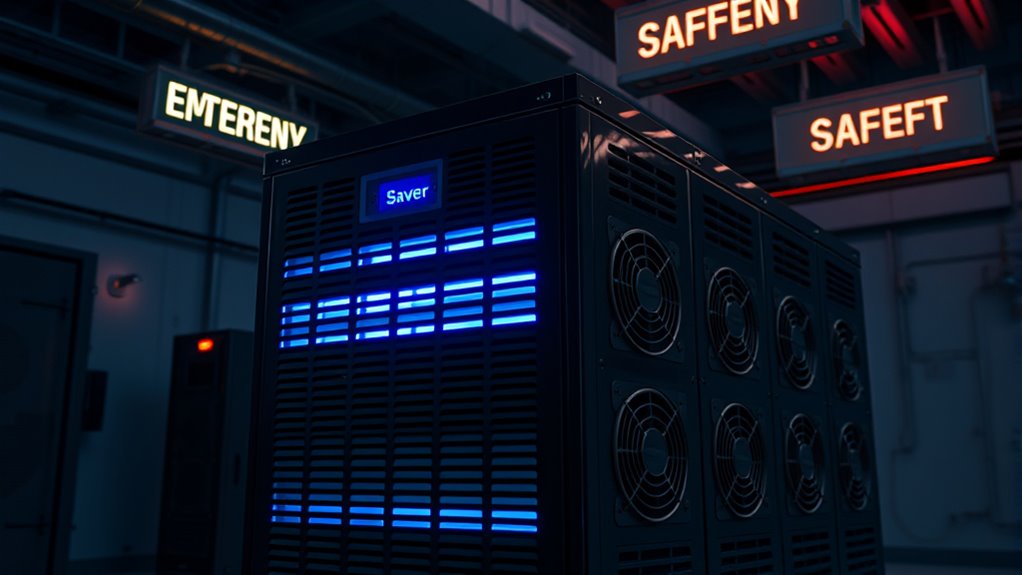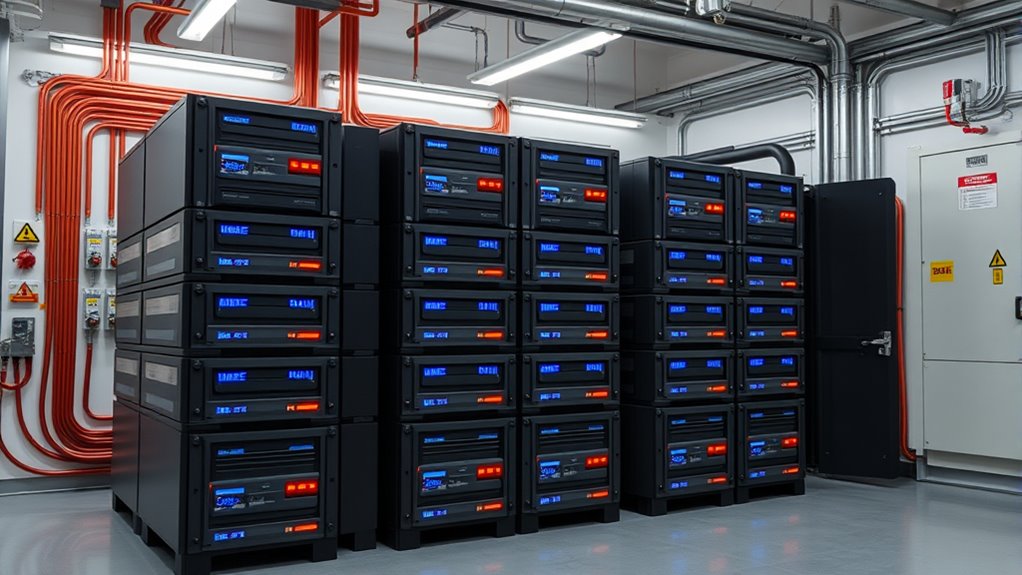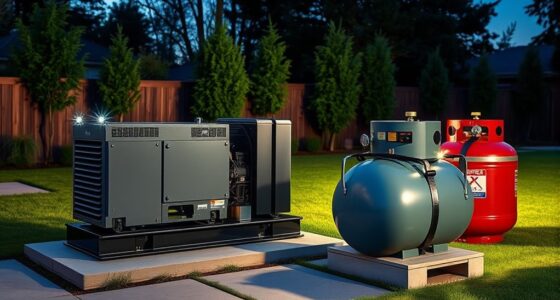Battery storage systems provide immediate power during emergencies by releasing stored energy when the grid fails or goes unstable. They capture excess energy from renewable sources or charge from the grid during normal times, then quickly supply electricity to keep your essential devices running. Unlike generators, they don’t need fuel or long startup times. This quick response boosts your safety and independence. Keep exploring how these systems can become your reliable backup in critical moments.
Key Takeaways
- Battery storage systems capture and store excess renewable energy for reliable use during power outages.
- They provide instant backup power, ensuring critical devices operate seamlessly during emergencies.
- Advanced monitoring and safety features optimize energy flow and protect the system in crisis situations.
- Storage systems enable grid independence by supplying stored energy without relying on external power sources.
- They support sustainable emergency response by reducing reliance on fossil fuels and enhancing resilience.

Battery storage systems are revolutionizing how we manage and utilize energy by capturing excess power for later use. When it comes to emergencies, these systems become even more essential, providing a reliable backup when the grid fails or becomes unstable. Imagine a situation where storms knock out power lines or natural disasters disrupt supply; your battery storage system steps in to keep essential devices running. By storing energy generated from renewable sources like solar panels or wind turbines, these systems foster greater grid independence. This means you’re less reliant on the traditional power grid, which can be unpredictable during emergencies, and instead, you have a dependable source of electricity on hand.
Battery storage enhances emergency resilience by providing reliable, renewable energy when the grid fails.
In emergency scenarios, the ability of battery storage to supply power instantly is critical. Unlike generators that may require fuel or start-up time, batteries deliver immediate energy, ensuring that your home or business remains operational without interruption. This instant response is especially important during blackouts, where every second counts. By integrating renewable energy into your storage system, you maximize resilience; when the sun isn’t shining or the wind isn’t blowing, your stored energy becomes your safety net. This reduces dependence on external power sources and enhances your overall energy security during critical times.
Battery storage systems also allow you to optimize energy use during emergencies. You can choose to draw from your stored energy rather than the grid, which might be compromised or more expensive during outages. This self-sufficiency not only offers peace of mind but can also reduce your energy costs in the long run. Additionally, these systems support the broader goal of a cleaner environment, as they enable you to rely more heavily on renewable energy, decreasing your carbon footprint. During emergencies, this shift to renewables helps make certain that your energy needs are met sustainably, even when traditional infrastructure is down.
Furthermore, modern battery systems are designed with safety and durability in mind, making them suitable for emergency preparedness. They are equipped with advanced monitoring and control features, allowing you to manage energy flow efficiently. Whether you’re powering critical medical equipment, communication devices, or essential appliances, a well-integrated battery storage system provides a dependable power source that enhances your independence. It’s a smart investment that transforms your energy setup into a resilient, renewable-powered system capable of weathering any storm. In essence, battery storage systems are not just about everyday energy management—they’re about ensuring safety, stability, and independence when it matters most. Additionally, many systems now incorporate advanced safety features, reinforcing their reliability in emergency situations.
Frequently Asked Questions
How Long Can a Battery Storage System Provide Power During an Outage?
You can expect a battery storage system to provide power during an outage for anywhere from a few hours to over a day, depending on its battery capacity and your energy needs. The power duration varies based on how much energy you draw and the system’s size. Smaller systems might last 4-6 hours, while larger setups with higher capacity can supply power for 12 hours or more during an emergency.
What Are the Safety Precautions for Handling Emergency Battery Systems?
When handling emergency battery systems, you should always wear protective gear and follow safety protocols. During emergency training, learn proper procedures for battery disposal to prevent hazards. Avoid puncturing or exposing batteries to extreme heat, and guarantee proper ventilation. Regularly inspect the batteries for damage or leaks, and handle them with care. Proper training and safety precautions help prevent accidents and ensure safe operation during power outages.
Can Battery Storage Systems Be Used With Renewable Energy Sources?
Yes, you can use battery storage systems with renewable energy sources like solar or wind. They enable renewable integration by storing excess energy for later use, helping you attain energy independence. When sunlight or wind isn’t available, your stored energy powers your home or business seamlessly. This setup guarantees a reliable, clean energy supply, reducing reliance on the grid and lowering your carbon footprint.
How Do Temperature Variations Affect Battery Storage Performance?
Temperature swings are like a roller coaster for your battery storage system, impacting its performance. Thermal effects cause capacity fluctuations, making batteries less efficient in extreme heat or cold. When it’s too hot, chemical reactions speed up, risking degradation. Cold temperatures slow down reactions, reducing capacity. To keep your system running smoothly, manage thermal effects with proper cooling or heating, ensuring stable performance despite temperature variations.
What Maintenance Is Required to Ensure Reliability During Emergencies?
To guarantee your battery storage system remains reliable during emergencies, follow a regular maintenance schedule. Check connections, inspect for corrosion, and monitor battery temperature to protect battery lifespan. Keep software updates current, and replace batteries nearing end-of-life. Proper maintenance prevents unexpected failures, ensuring your system performs at its best when you need it most. Staying proactive with these steps helps extend battery life and guarantees dependable emergency power.
Conclusion
Now that you know how battery storage systems work in emergencies, imagine what could happen if you truly need them when it counts most. Will they be enough to keep your essentials running? The truth is, the future of emergency preparedness hinges on these powerful systems—ready to surprise you when you least expect it. Stay tuned, because the next breakthrough might just change everything you thought you knew about staying safe during a crisis.









